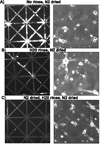Hippocampal networks on reliable patterned substrates
- PMID: 21985763
- PMCID: PMC3246106
- DOI: 10.1016/j.jneumeth.2011.09.020
Hippocampal networks on reliable patterned substrates
Abstract
Toward the goal of reproducible live neuronal networks, we investigated the influence of substrate patterns on neuron compliance and network activity. We optimized process parameters of micro-contact printing for reproducible geometric patterns of 10 μm wide lines of polylysine with 4, 6, or 8 connections at a constant square array of nodes overlying the recording electrodes of a multielectrode array (MEA). We hypothesized that an increase in node connections would give the network more inputs resulting in higher neuronal outputs as network spike rates. We also chronically stimulated these networks during development and added astroglia to enhance network activity. Our results show that despite frequent localization of neuron somata over the electrodes, the number of spontaneously active electrodes was reduced 3-fold compared to random networks, independent of pattern complexity. Of the electrodes active, the overall spike rate was independent of pattern complexity, consistent with homeostasis of activity. Lower mean burst rates were seen with higher levels of pattern complexity; however, burst durations increased 1.6-fold with pattern complexity (n=6027 bursts, p<0.001). Inter-burst interval and percentage of active electrodes displaying bursts also increased with pattern complexity. The extra-burst (non-burst or isolated) spike rate increased 4-fold with pattern complexity, but this relationship was reversed with either chronic stimulation or astroglia addition. These studies suggest for the first time that patterns which limit the distribution of branches and inputs are deleterious to activity in a hippocampal network, but that higher levels of pattern complexity promote non-burst activity and favor longer lasting, but fewer bursts.
Copyright © 2011 Elsevier B.V. All rights reserved.
Conflict of interest statement
Potential conflict of interest: Dr. Brewer owns BrainBits LLC, the supplier and manufacturer of NbActiv4 culture medium.
Figures








References
-
- Bologna LL, Pasquale V, Garofalo M, Gandolfo M, Baljon PL, Maccione A, Martinoia S, Chiappalone M. Investigating neuronal activity by SPYCODE multi-channel data analyzer. Neural Netw. 2010;23:685–697. - PubMed
-
- Branch DW, Corey JM, Weyhenmeyer JA, Brewer GJ, Wheeler BC. Microstamp patterns of biomolecules for high-resolution neuronal networks. Med Biol. Eng Comput. 1998;36:135–141. - PubMed
-
- Branch DW, Wheeler BC, Brewer GJ, Leckband DE. Long-term stability of grafted polyethylene glycol surfaces for use with microstamped substrates in neuronal cell culture. Biomaterials. 2001;22:1035–1047. - PubMed
Publication types
MeSH terms
Grants and funding
LinkOut - more resources
Full Text Sources

